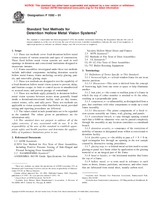We need your consent to use the individual data so that you can see information about your interests, among other things. Click "OK" to give your consent.
ASTM F1592-01
Standard Test Methods for Detention Hollow Metal Vision Systems
STANDARD published on 10.12.2001
The information about the standard:
Designation standards: ASTM F1592-01
Note: WITHDRAWN
Publication date standards: 10.12.2001
SKU: NS-50848
The number of pages: 10
Approximate weight : 30 g (0.07 lbs)
Country: American technical standard
Category: Technical standards ASTM
Annotation of standard text ASTM F1592-01 :
Keywords:
battering ram, correctional facility, detention facility, detention security, fire test, frame, hollow metal, fixed detention hollow metal vision system, impact test, physical security, security hollow metal, ICS Number Code 91.040.10 (Public buildings)
Additional information
| 1. Scope | ||||||||||||||||||
|
1.1 These test methods cover fixed detention hollow metal vision systems of various materials and types of construction. These fixed hollow metal vision systems are used in wall openings in detention and correctional institutions designed to incarcerate inmates. 1.2 Frame assemblies investigated under these test methods include individual components including detention security hollow metal frames, frame anchoring, security glazing, panels, and removable glazing stops. 1.3 These test methods are designed to test the capability of a fixed detention hollow metal vision system to prevent, delay, and frustrate escape; to limit or control access to unauthorized or secured areas; and prevent passage of contraband. 1.4 These test methods apply primarily to detention hollow metal vision systems between secure areas generally found inside a detention/correctional facility such as: day rooms, control rooms, cells, and sally ports. These test methods are applicable to vision systems other than hollow metal, provided testing and reporting procedures are followed. 1.5 The values stated in inch-pound units are to be regarded as the standard. The values given in parentheses are for information only. 1.6 This standard does not purport to address all of the safety concerns, if any, associated with its use. It is the responsibility of the user of this standard to establish appropriate safety and health practices and determine the applicability of regulatory limitations prior to use. |
||||||||||||||||||
| 2. Referenced Documents | ||||||||||||||||||
|
We recommend:
Technical standards updating
Do you want to make sure you use only the valid technical standards?
We can offer you a solution which will provide you a monthly overview concerning the updating of standards which you use.
Would you like to know more? Look at this page.




 Cookies
Cookies
